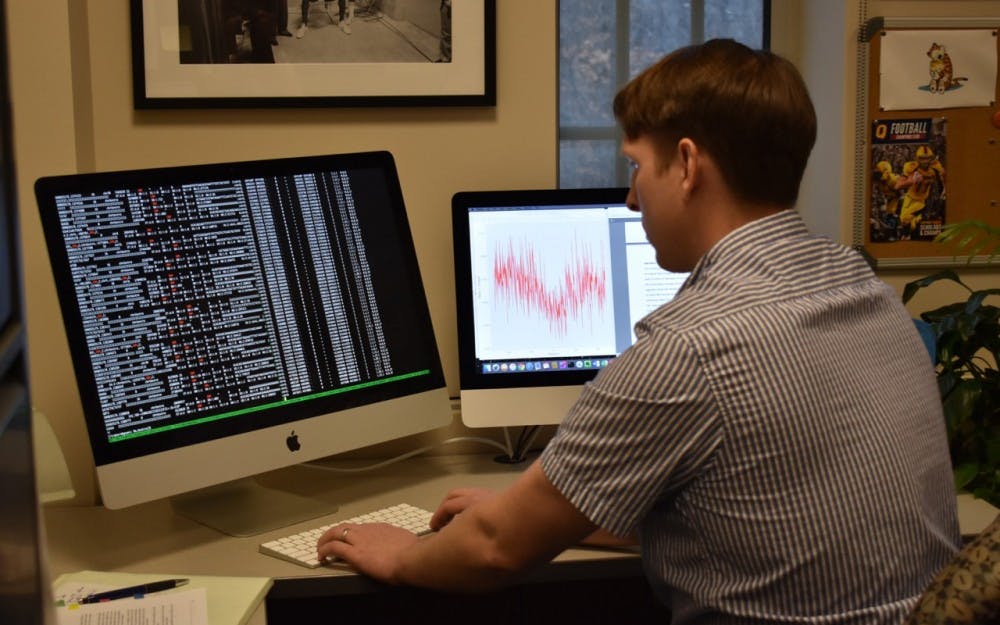Volker Brendel, professor of biology and computer science, looks at strings of numbers on a dark computer screen. Behind the data lie the solutions to hunger and malnutrition.
At the crossroads of computer science and biology, bioinformatics scientists use software to study genetics down to the nucleotide — a single base of DNA.
Brendel, recently named a fellow of the American Association for the Advancement of Science, uses a mix of experimental and computational work to study rice genetics with the hopes of addressing global issues in hunger and malnutrition.
“The plant breeders and the plant genomics scientists are working together really heavily to figure out what are the sensible approaches to potentially increase the yield and in particular to make the plants more resistant to stresses,” Brendel said.
Working with rice researchers from Iowa to the Philippines, Brendel studies the genomes, the genetic material of an organism, that make each plant the way it is.
The global quantity of rice, a major source of food in the world, can easily be lost due to pathogens or high salt concentrations, Brendel said.
Plants, sensitive to these changes in their environment, respond to these changes depending on their biological makeup.
“Even a small change in temperature will bring in different tolerances in plants,” Brendel said.
As population worldwide increases and the amount of arable land available doesn’t, scientists like Brendel work to make rice resistant to these stresses and, in turn, increase the crop’s yield.
In bioinformatics, experimental scientists extract DNA from crops in the lab and upload the information to computer databases.
Computational scientists then use software and data analysis to study the biological phenomena, such as proteins that control genetic expression or locations of DNA transcription into RNA — a precursor to proteins.
One such computational method, RNA-Seq, studies the RNA from experimental samples to identify areas of genetic expression in DNA.
Brendel uses RNA-Seq to compare genetic expression between salt-resistant and salt-tolerant rice to figure out what genetically makes these plants different.
With a balance of these two phases, experimental and computational, these scientists uncover ways to optimize plant growth.
With the immense size of these genomes, each 300 million nucleotides, Brendel’s lab harnesses the power of computers.
“The Chinese have sequenced 3,000 rice genomes,” Brendel said, “Overall there are 150,000 in the world.”
Brendel said scientists are still figuring out the best ways to analyze these 3,000 genomes.
“For a particular biologist this is a treasure trove but they have no idea what to do with it,” Brendel said.
Taylor Raborn, a postdoctoral researcher in the lab, helped introduce the lab to experimental work two months ago.
“In order to investigate the problems you wanna investigate you have to be close to the sources of the data,” Raborn said.
Raborn studies methods to identify promoters, areas of DNA that begin transcription, and, in turn, where genetic expression is controlled.
Improving on previous studies, Raborn has worked to study the promoters for genes in plant growth with precision.
In Brendel’s lab, Raborn is involved in all stages of the process.
Brendel also encourages undergraduate science students to learn basic computer programming, such as through his spring 2017 course BIOL L388: Digital Biology: A Survey of Topics in Bioinformatics and Functional Genomics. This course would teach students the basics of bioinformatics.
“It is absolutely essential that biologists learn to work with computers as early as possible,” Brendel said.
In addition to access to online data of plant genomes or biological features, Brendel said students should learn how to perform data analysis using computational software.
“We have the compute facilities that make all of this possible,” Brendel said about IU’s research resources. “We get all the help you can think of.
Brendel also works to overcome issues of reproducibility, the capacity of an experiment for reproduction by other scientists, in bioinformatics.
The lab members document their work thoroughly through workflows, Brendel said.
These workflows are plans of every step of the process, from notes in computer code to re-evaluating extraction methods.
Providing open source details of these processes, Brendel’s lab fosters communication and analysis between other scientists with greater ease and addresses these issues of reproducibility.
“We take pride in our work,” Brendel said. ”We try to turn everything that we do into basically into a workflow that gives reproducible or scalable results.”




